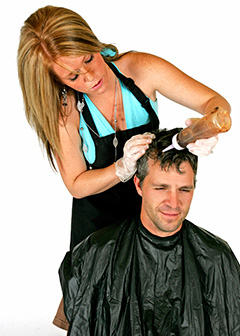How to Become a Barber, Hairdresser, or Cosmetologist About this section

Workers must obtain a license through a state-approved barber or cosmetology program.
All states require barbers, hairdressers, and cosmetologists to be licensed. To qualify for a license, candidates are required to graduate from a state-approved cosmetology program. Shampooers do not need a license.
Education and Training
A high school diploma or equivalent is required for some positions. In addition, every state requires that barbers, hairdressers, and cosmetologists complete a program in a state-licensed barber or cosmetology school. Programs in hairstyling, skin care, and other personal appearance services are available both in high schools and in public or private postsecondary vocational schools.
Full-time programs in barbering and cosmetology usually last at least 9 months and may lead to an associate’s degree. Most of these workers take advanced courses in hairstyling or in other personal appearance services to keep up with the latest trends. Those who want to open their own business also may take courses in sales and marketing.
Shampooers do not need formal training. Some short-term on-the-job training under the supervision of a hairstylist or a more experienced shampooer is sufficient.
Licenses
All states require barbers, hairdressers, and cosmetologists to be licensed. Qualifications for a license vary by state; but generally, a person must have a high school diploma or equivalent, be at least 16 years old, and have graduated from a state-licensed barber or cosmetology school. After graduating from a state-approved training program, students take a state licensing exam. The exam includes a written test and, in some cases, a practical test of styling skills or an oral exam.
In many states, cosmetology training may be credited toward a barbering license, and vice versa, and a few states combine the two licenses. A fee is usually required to apply for a license, and periodic license renewals may be necessary.
Some states have reciprocity agreements that allow licensed barbers and cosmetologists to get a license in another state without needing additional formal training, but such agreements are uncommon. Consequently, people who want to work in a particular state should review the laws of that state before entering a training program.
Important Qualities
Creativity. Barbers, hairdressers, and cosmetologists must keep up with the latest trends and be able to try new hairstyles for their clients.
Customer-service skills. To help retain clients, barbers, hairdressers, and cosmetologists must be pleasant, friendly, and able to interact with customers.
Listening skills. Barbers, hairdressers, and cosmetologists should be good listeners. They must listen carefully to what the client wants to make sure the client is happy with the result.
Stamina. Barbers, hairdressers, and cosmetologists must be able to stand on their feet for long periods of time.
Time-management skills. Time management skills are important when scheduling appointments and providing services. For example, routine haircuts and trims do not require the precise timing of some other services, such as applying neutralizer after a permanent wave. Clients who receive timely hair care service are more likely to return.
In addition, barbers, hairdressers, and cosmetologists must keep a neat personal appearance and must keep their work area clean and sanitary. This is necessary for the health and safety of their clients, as well as to make clients comfortable enough to want to return.






